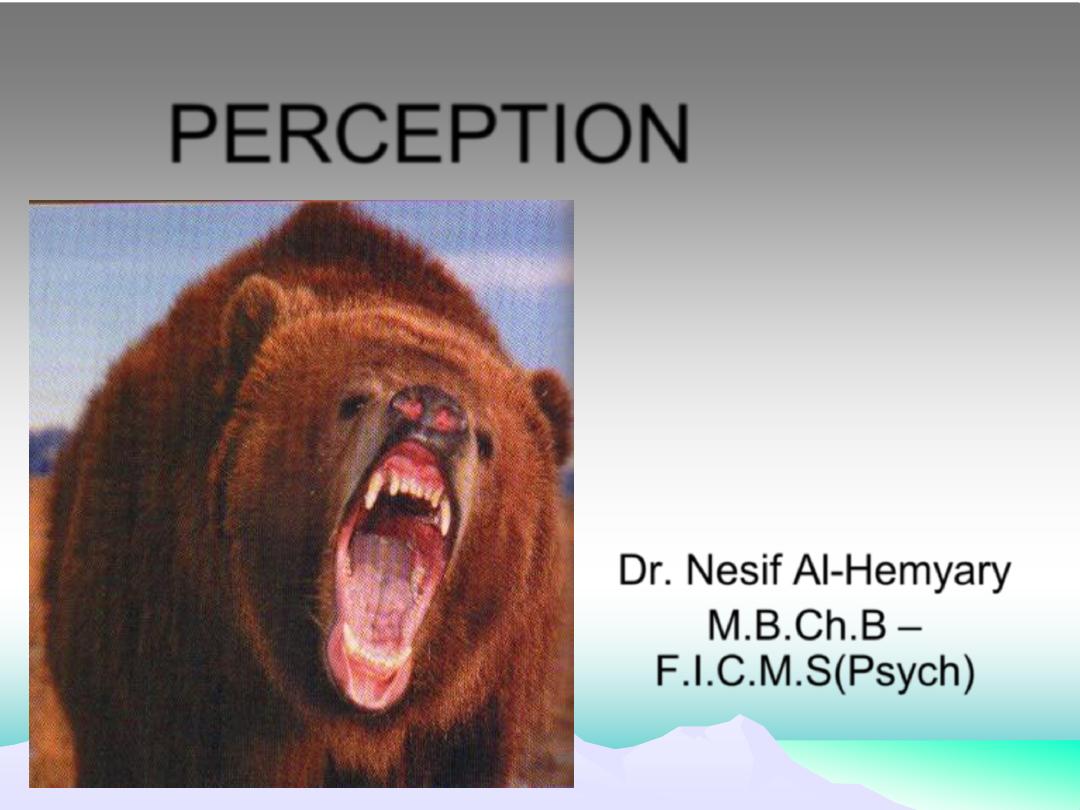
PERCEPTION
Dr. Nesif Al-Hemyary
M.B.Ch.B
–
F.I.C.M.S(Psych)
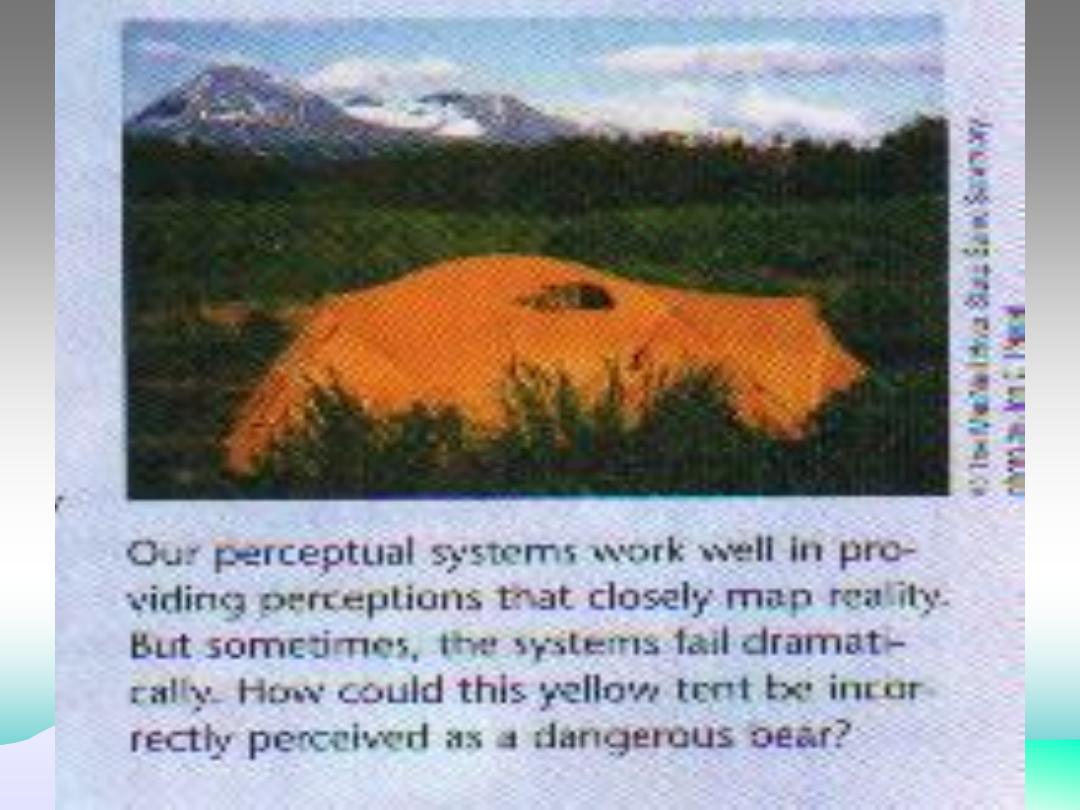
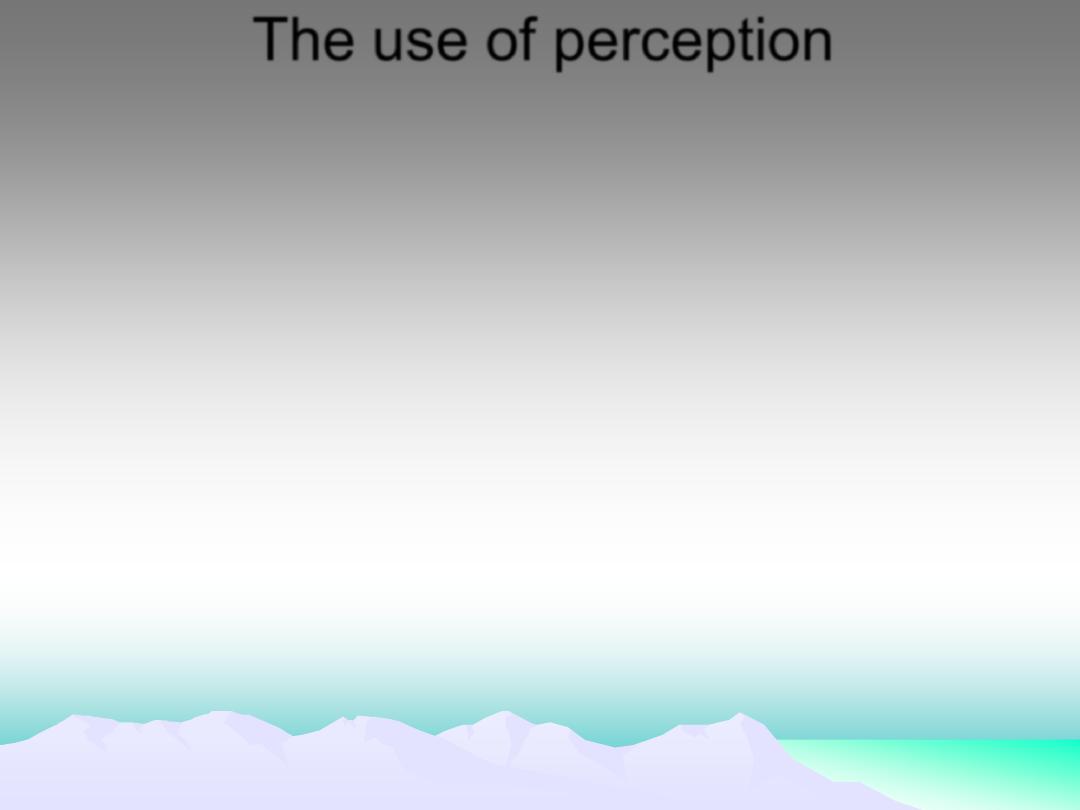
The use of perception
•
The study of perception deals with the
question of how organisms process and
organize incoming raw sensory
information in order to :
1.
Form a coherent representation or
model of the world within which the
organism dwells.
2.
Use that representation to solve naturally
occurring problems such as navigating
,grasping and planning.
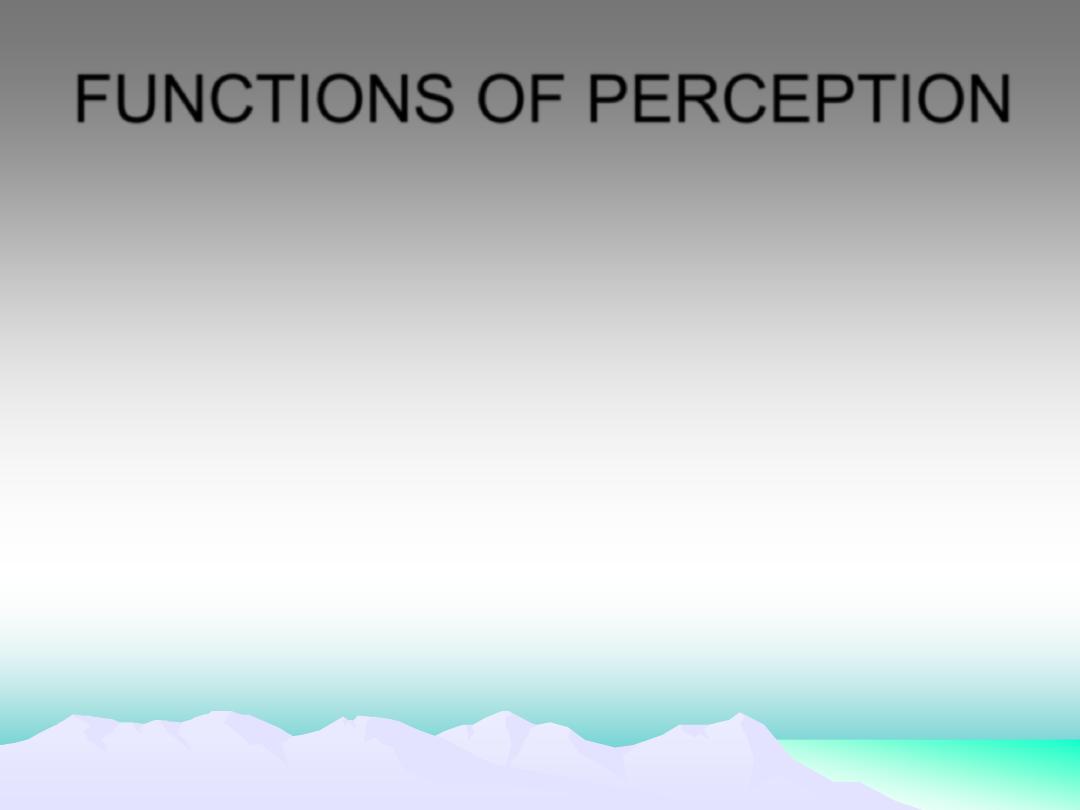
FUNCTIONS OF PERCEPTION
1.
Attention.
2.
Localization.
3.
Recognition.
4.
Abstraction.
5.
Constancy.
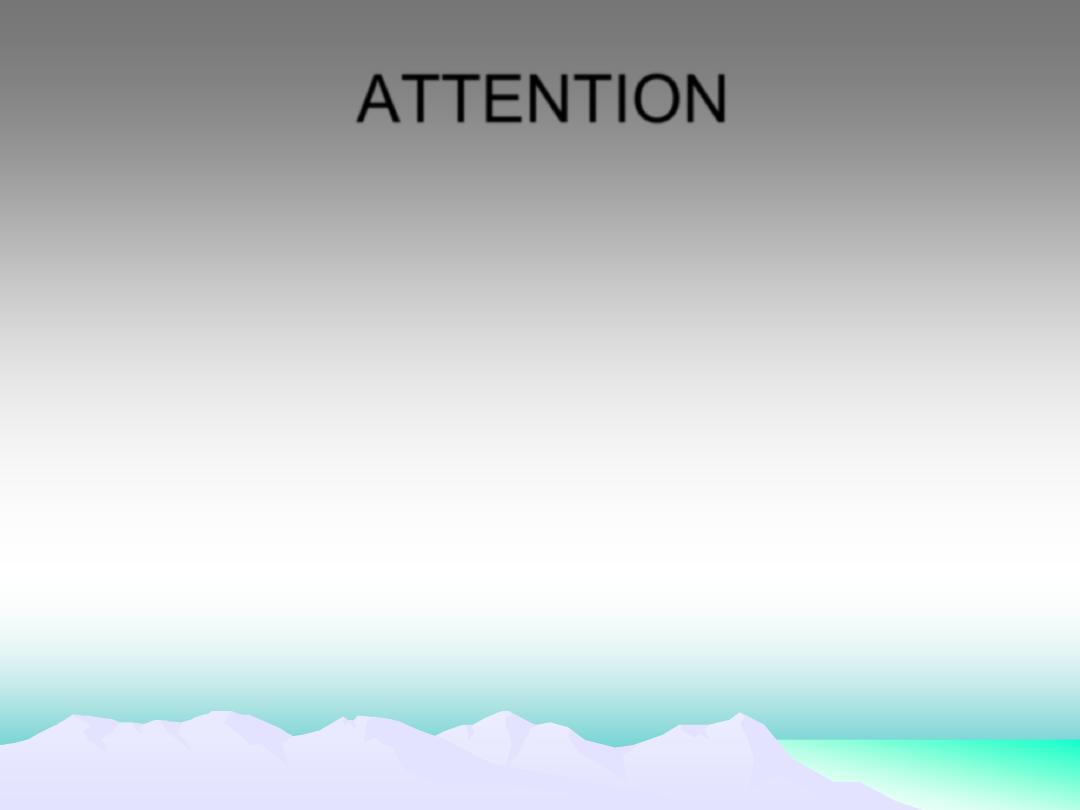
ATTENTION
•
The sensory system and the brain must have some
means of screening the incoming information- allowing
through only the information relevant to the task at hands
and filtering out the irrelevant information.
•
Indeed, when we look at the sensory organs and certain
parts of the brain ,we discover that a major design
feature is filters that allow them to screen and select
incoming information along various dimensions.
•
Roughly speaking, the sum total of all these filters is
what is known as attention.
•
Our various filters are adjusted to screen out all but the
information that is required for the task at hand.
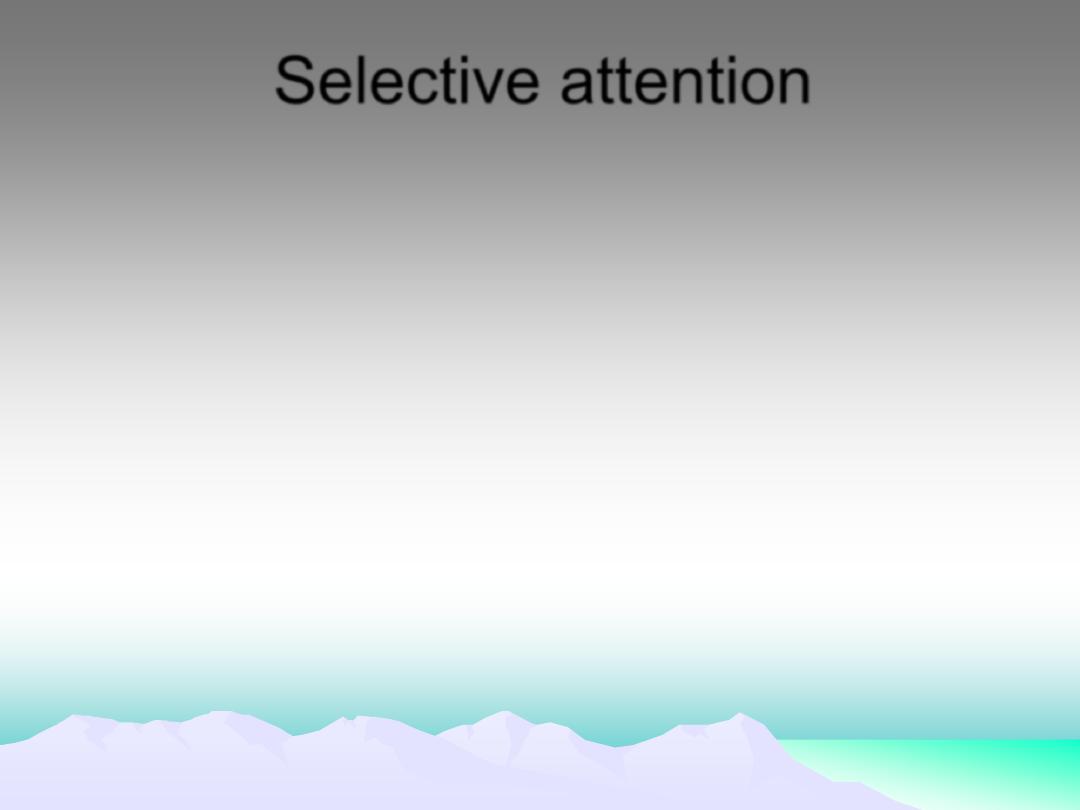
Selective attention
•
Selecting some stimuli for further processing while ignoring others.
•
IN VISION
•
Eye Movements: visual scanning takes the form of fixations
separated by saccades.
•
Fixation: are brief periods during which the eyes are relatively
stationary, fixation lasts approximately 300msec.
•
Saccade: are quick jumps of the eye from one place to the next, it is
very fast (20msec).
•
We can also selectively attend to some visual stimulus without
moving our eyes.
•
Attention is multimodal: it can move within a modality, such as from
one visual stimulus to another, or between modalities (like shifting
our attention from watching the road while driving to listening to the
person who just called our cell phone).
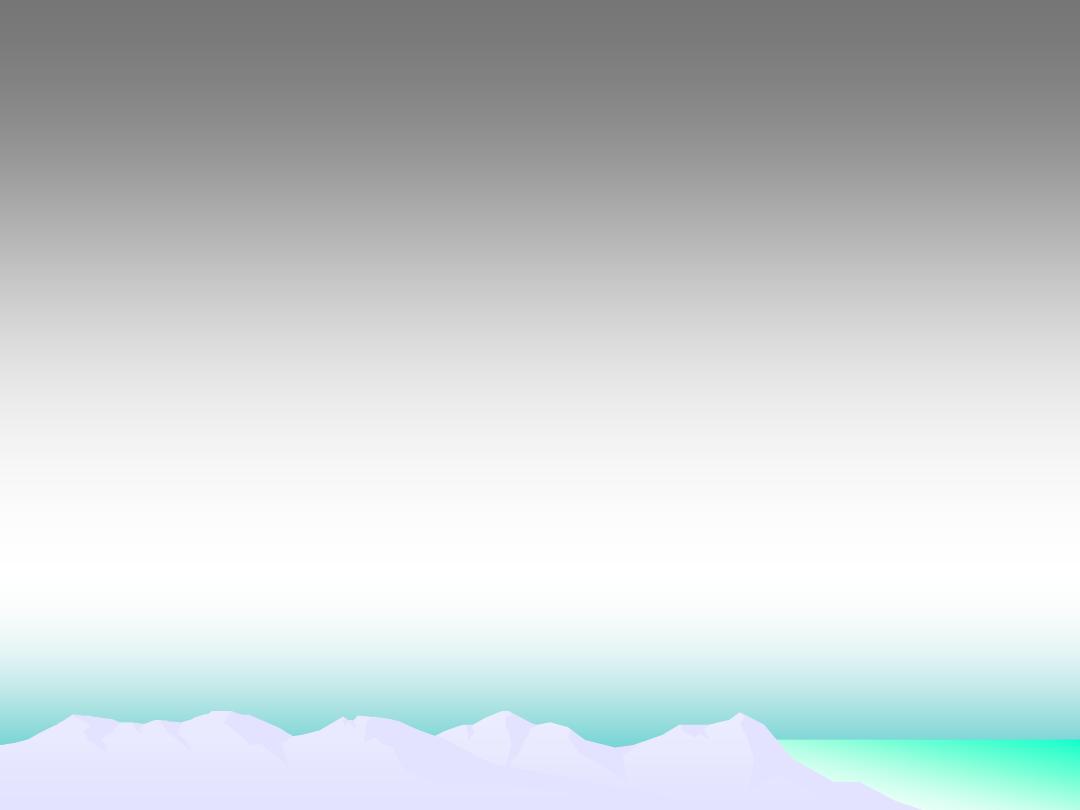
•
IN AUDITION :
•
By using cues such as:
1.
Direction of the voice
2.
Speakers lip movements
3.
Particular characteristics of the speakers voice
4.
Meaning
•
Lack of attention does not block messages
entirely: rather it attenuates them.
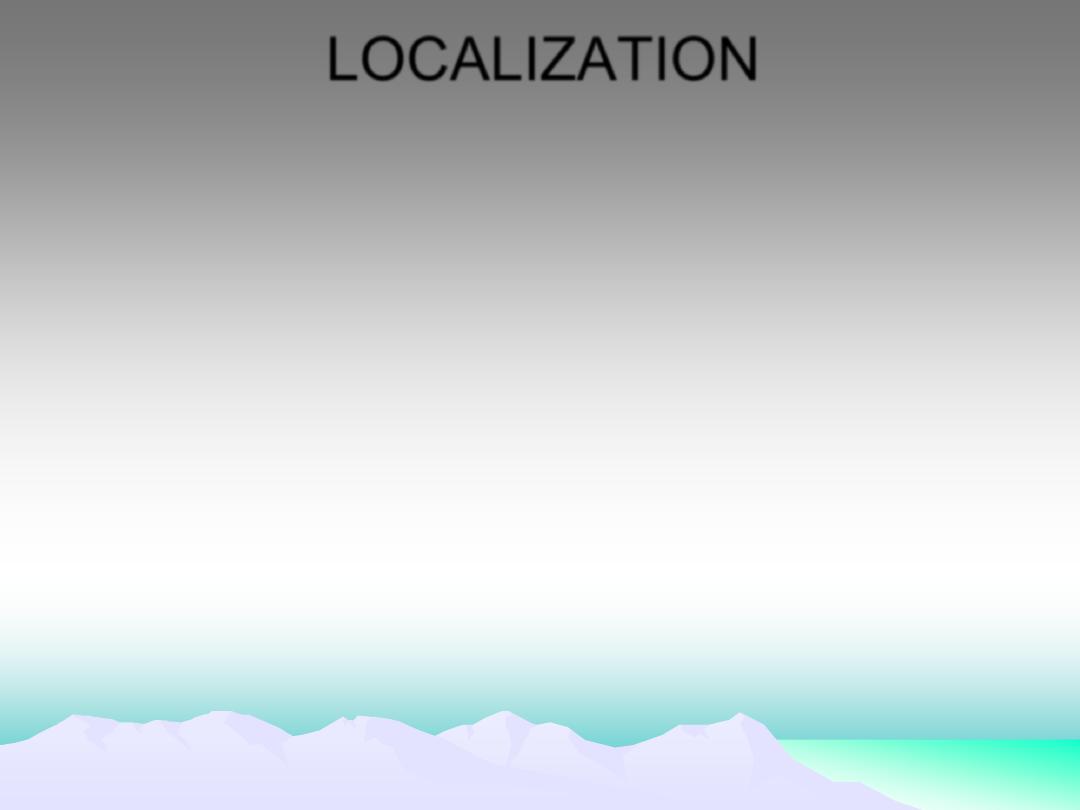
LOCALIZATION
•
To know where the subjects in our environment are, we first have to
separate the objects from one another and from the background then the
perceptual system can determine the position of the objects in a three-
dimensional world, including their distance from us and their patterns of
movements.
•
A- Separation of objects:
•
Figure and ground principle
:the most elementary form of perceptual
organization is that in a stimulus with two or more distinct regions, we
usually see part of it as a figure and the rest as ground (or background).
The regions seen as a figure contain the objects of interests which appear
more solid than the ground and appear in front of it. The ground is the
region that appears to be behind the figure.
•
Grouping of objects
: we see not only objects against a ground but also
objects in a particular grouping as well.
•
The Gestalt psychologists proposed a no. of determinants of grouping :
1.
Grouping by proximity.
2.
Grouping by similarity.
3.
Good continuation.
4.
Closure.
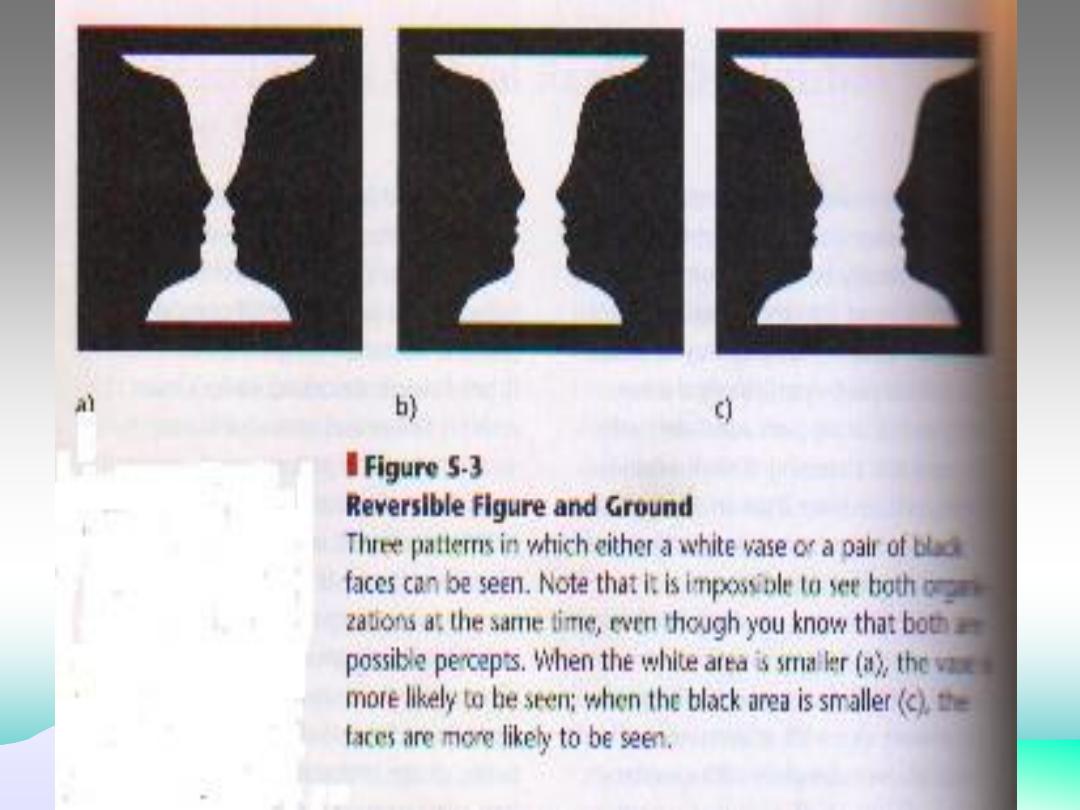
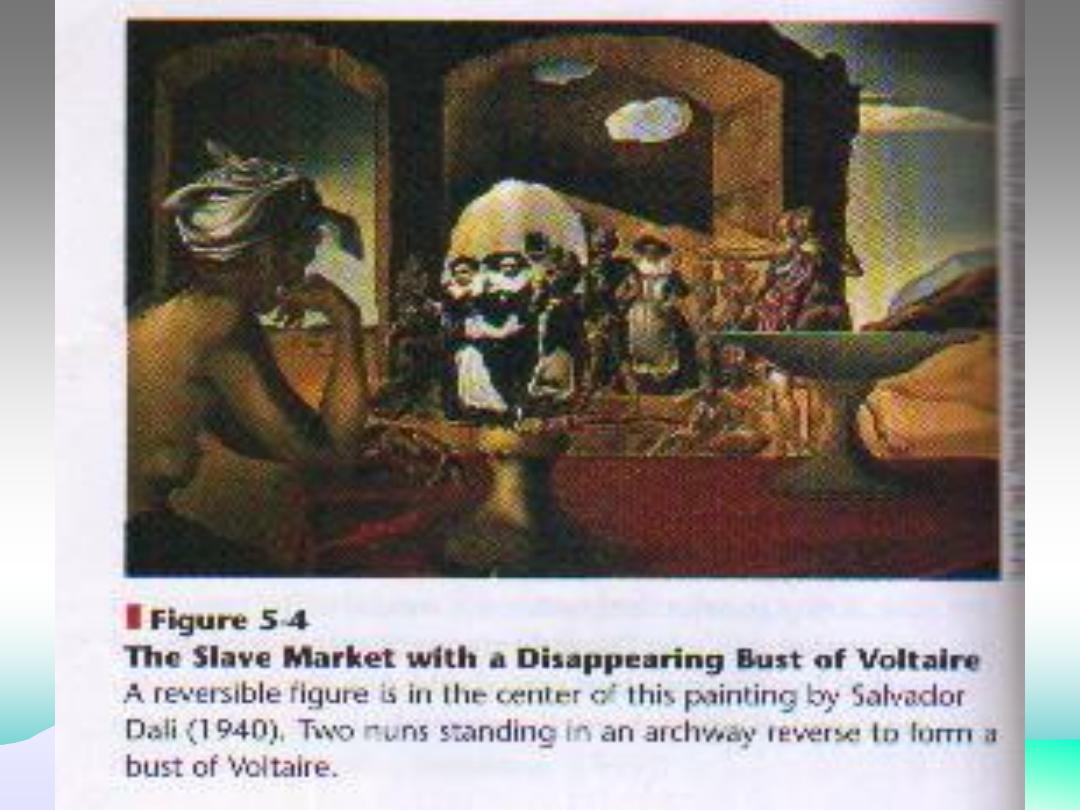
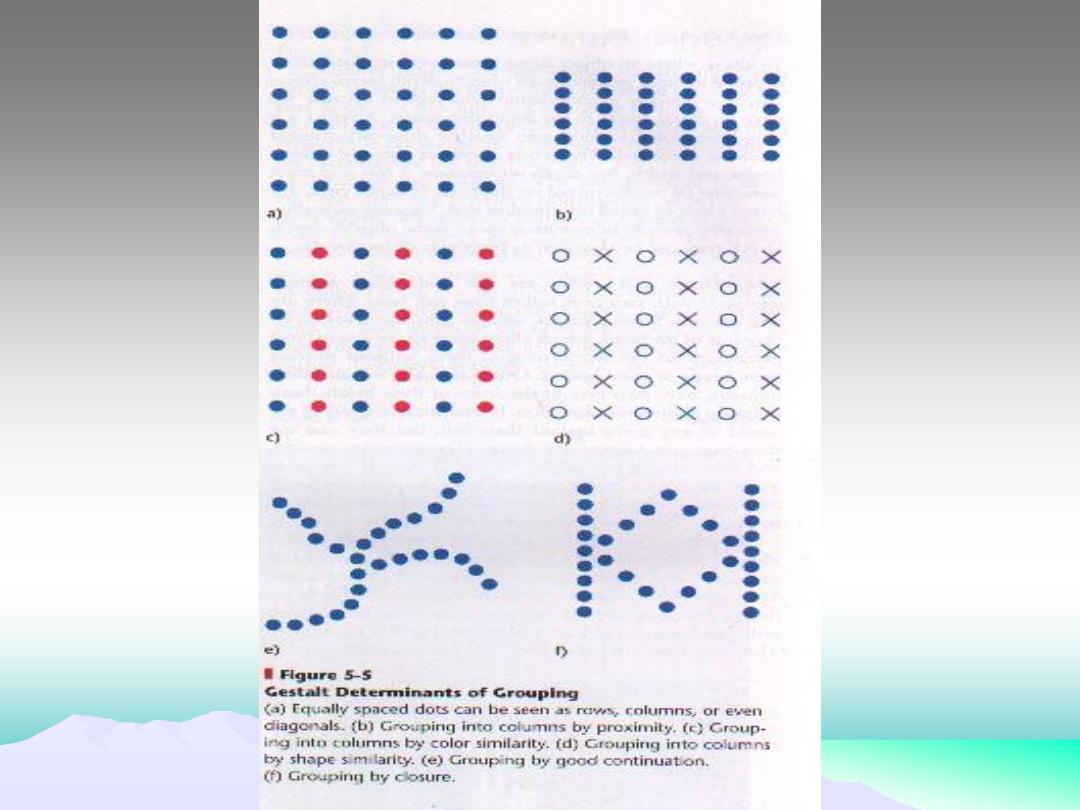

Localization- continued
•
B. Perceiving Distance: to know where an object is we must know its distance or depth(
Depth perception
).
•
DEPTH CUES :Different kinds of visual information that logically or mathematically ,provide information
about some object’s depth.
•
A-
Binocular depth cues: the two eyes’ ability to jointly infer depth comes about because the eyes are
separated in the head and each eye has a slightly different view of the same scene.
•
BINOCULAR D.C:
Different views by each eye (the index finger experiment)
•
Binocular disparity: refers to the difference in the views seen by each eye. The disparity is largest for
objects at close range and becomes smaller as the object recedes into the distance.
•
MONOCULAR D.C:
•
Binocular cues are limited to objects that are relatively close; monocular depth cues must be used, the
visual system has to make use of a hodgepodge of available information in the environment to come to a
conclusion.
1.
relative size.
2.
Interposition.
3.
relative height.
4.
Perspective.
5.
shading and shadows.
6.
relative motion.
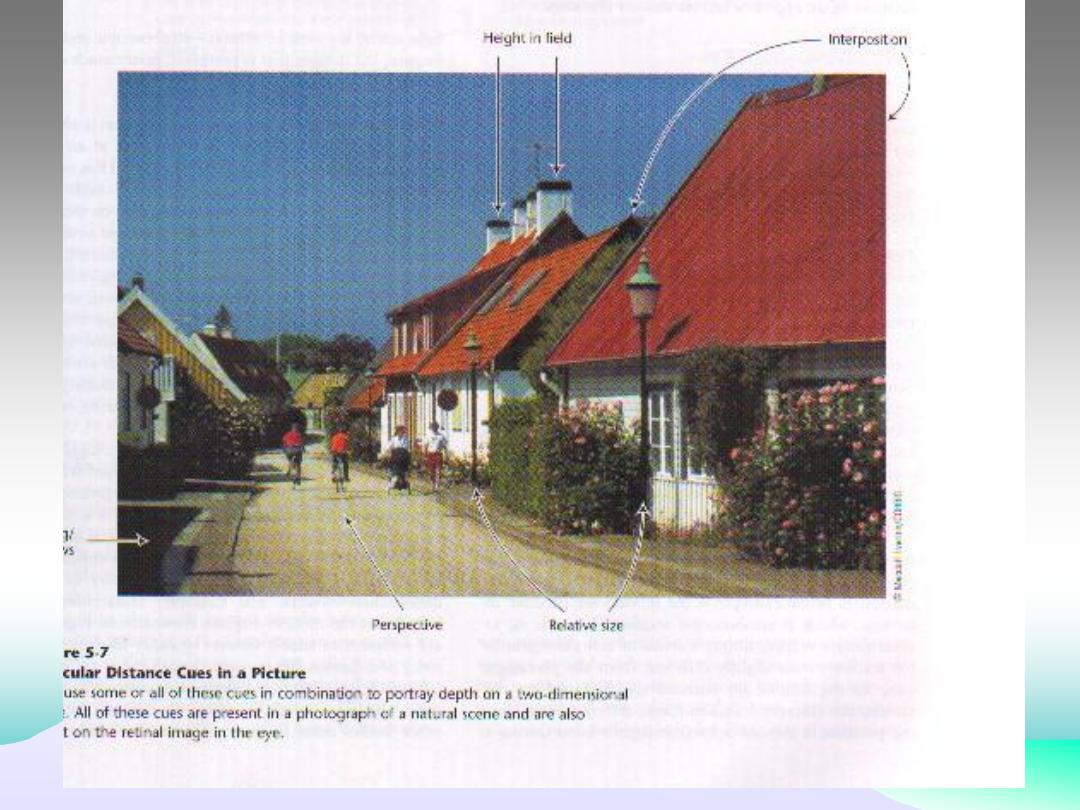

Perceiving motion
•
To move around our environment effectively, we need to
know not only the location of stationary objects but also the
trajectories of moving ones.
•
Localizing an object sometimes requires that we know the
direction in which an object is moving.
•
Stroboscopic motion
: is produced most simply by flashing a
light in darkness and then, a few milliseconds later, flashing
another light near the location of the first light. The light will
seem to move from one place to the other in a way that is
indistinguishable from real motion. A movie is, as most
people realize simply a series of still photographs (or
frames), each slightly different from the preceding one.
•
Real motion:
of course, our visual system is also sensitive to
real motion- that is, movement of an object through all
intermediate points in space. This is a complicated task
which can be attributed to many things:
•
A- movement of the eye over a stationary scene.
•
B- moving objects across our visual field.

•
Our analysis of motion is highly relative. We are much better at
detecting motion when we can see an object against a structured
background (relative motion) than when the background is a uniform
color and only the moving object can be seen( absolute movement).
•
Selective adaptation: is an important phenomenon in the study of
real motion. This is a loss in sensitivity to motion that occurs when
we view motion; the adaptation is selective in that we lose sensitivity
to the motion viewed and to similar motions , but not to motion that
differs significantly in direction or speed. If we look at upward-
moving stripes, for example, we lose sensitivity to upward motion
,but our ability to see downward motion is not affected.
•
How does the brain implement the perception of real motion?
1.
Some aspects of real motion are coded by specific cells in the visual
cortex, these cells respond to some motions but not to others, and
each cell responds best to one direction and speed of motion.
2.
Motor regions input about our eye movements to the visual cortex.
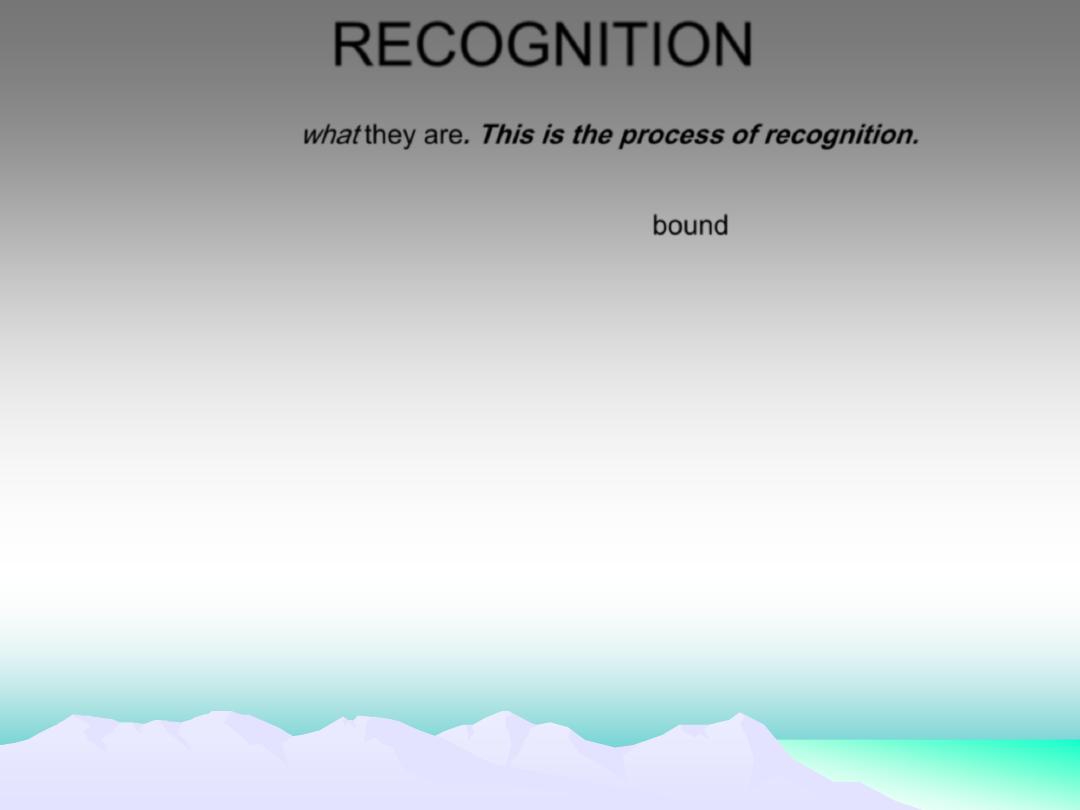
RECOGNITION
•
The perceptual system needs to determine not only where relevant objects are in
the scene but also
what
they are
. This is the process of recognition.
•
Recognizing an object requires that the various features associated with the
object ( such as shapes and colors) be correctly bound together.
•
Recognizing an object amounts to assigning it to a category and is based mainly
on the shape of the object.
•
Recognition occurs through two stages:
•
Early stages: using retinal information to describe the object in terms of features
like lines and angles. There are specialized cells in the visual cortex called
feature detectors. There are three types of these cells simple ,complex, and
hyper-complex, each type respond to certain shape features.
•
Later stages: matching of features with shape descriptions stored in memory..
•
Features of objects are more complex than lines, they are rather geometric forms
such as cylinders ,cones , blocks ,and wedges.
•
Perception of an object is easier when it fits the context in which it occurs : this is
particularly true of ambiguous figures (figures that can be perceived in more than
one way ).
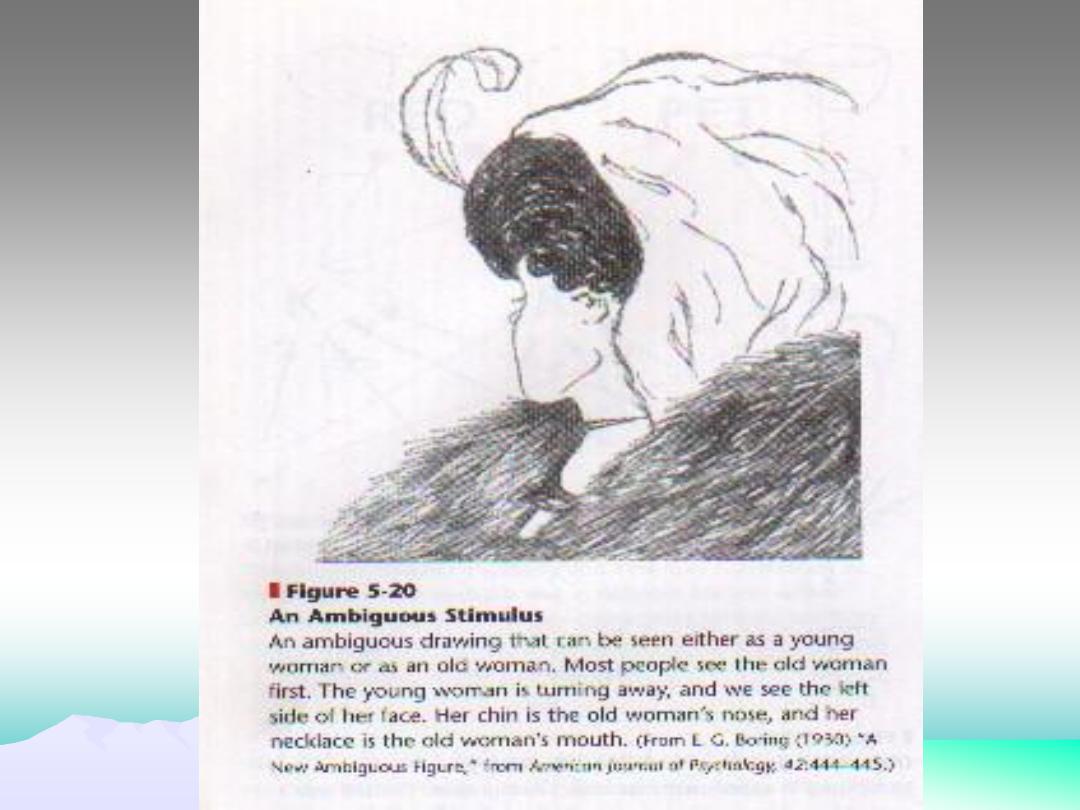
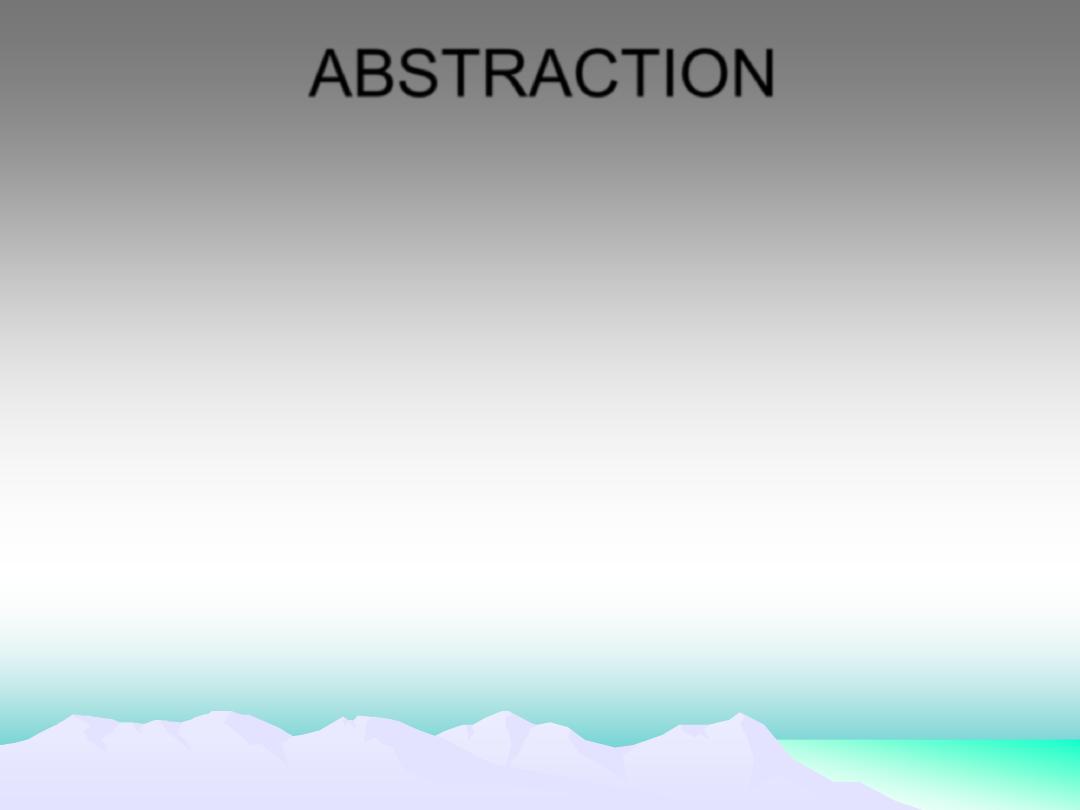
ABSTRACTION
•
The process of reducing the vast amount of information that
comes in from the physical world through our senses to a
more manageable set of categories.
•
To see what we mean ,note that the physical description of
an object is a listing of all the information necessary to
completely reproduce the object.
•
The physical description of most real-life ,natural objects is
enormously complicated.
•
We really, don’t need to know the infinite visual details.
Rather we need only enough to carry out whatever task is
requiring us to perceive the object to begin with.
•
Clearly, it is more efficient in many respects to perceive and
encode in memory an abstraction of the object rather than an
exact representation of the object itself.

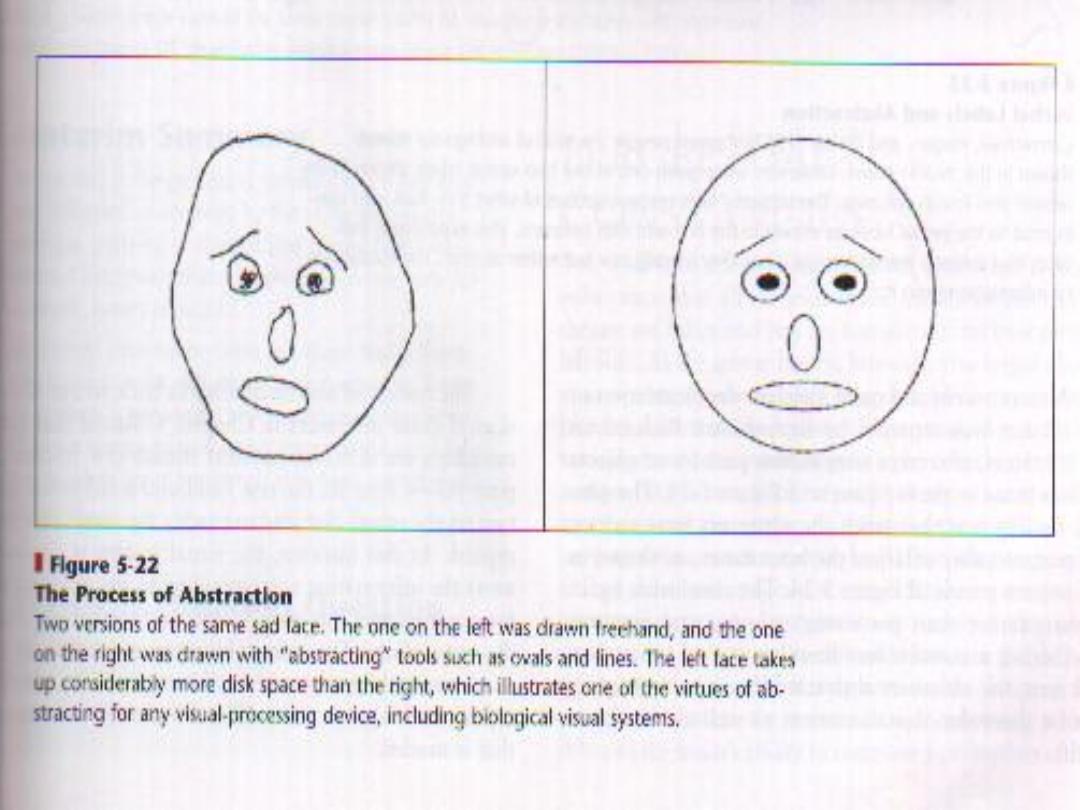
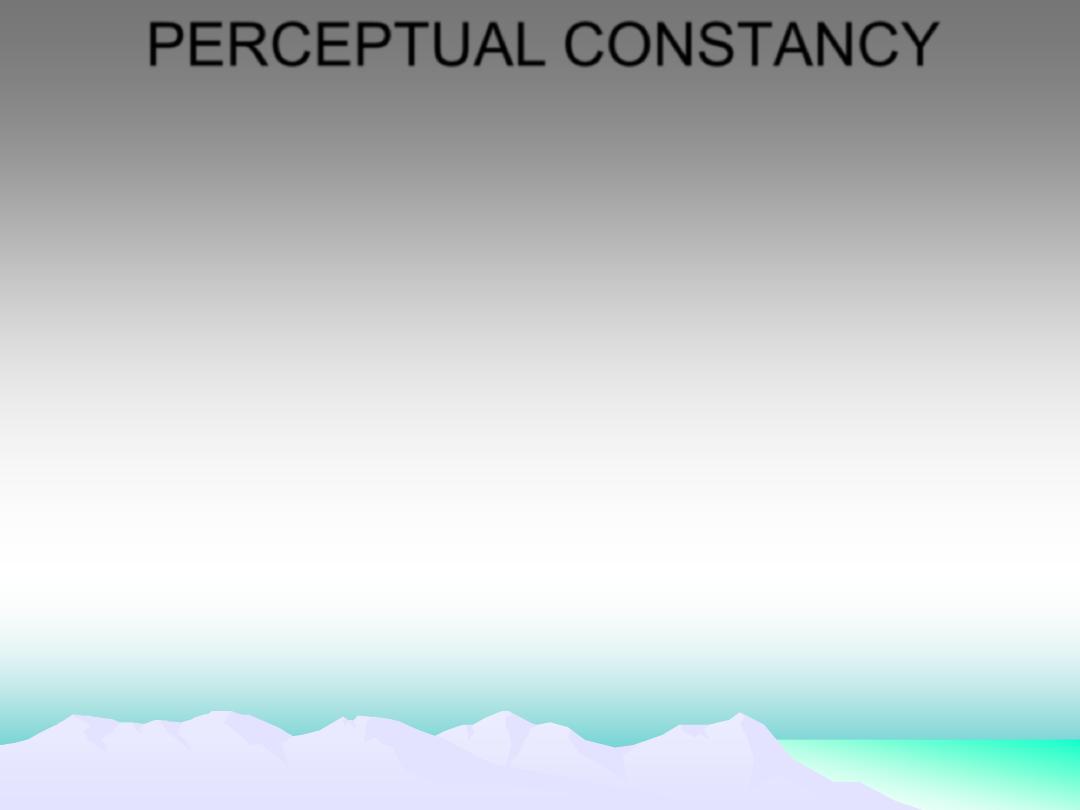
PERCEPTUAL CONSTANCY
•
Constancy refers to the brains ability to maintain a
perception of the underlying physical characteristics
of an object, such as shape , size, or color, even
when the sensory manifestations of this object
change drastically.
•
Color and brightness constancy
: depend on the
relations among the intensities of light reflected from
the different objects. By using our past knowledge of
object colors in general , our visual system is able to
correct for the effect of the source illumination( both
the source intensity and the source wavelengths)
and arrive at the brightness and the color of objects
we see.
•
Shape constanc
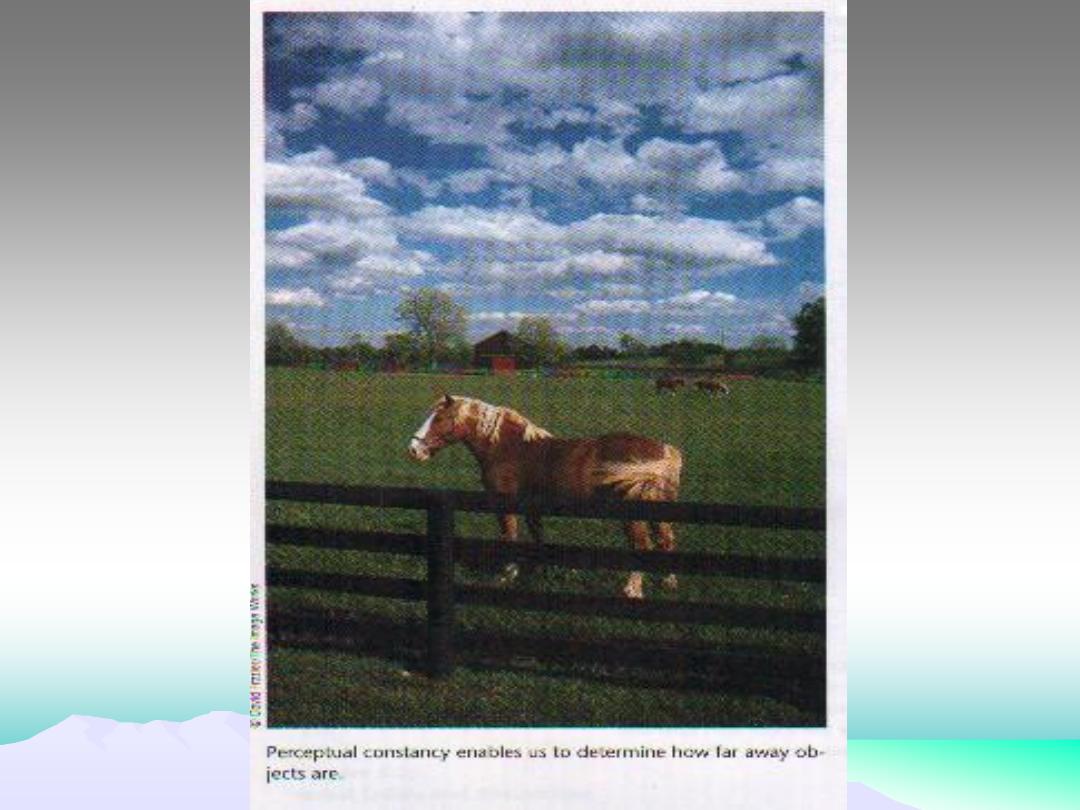
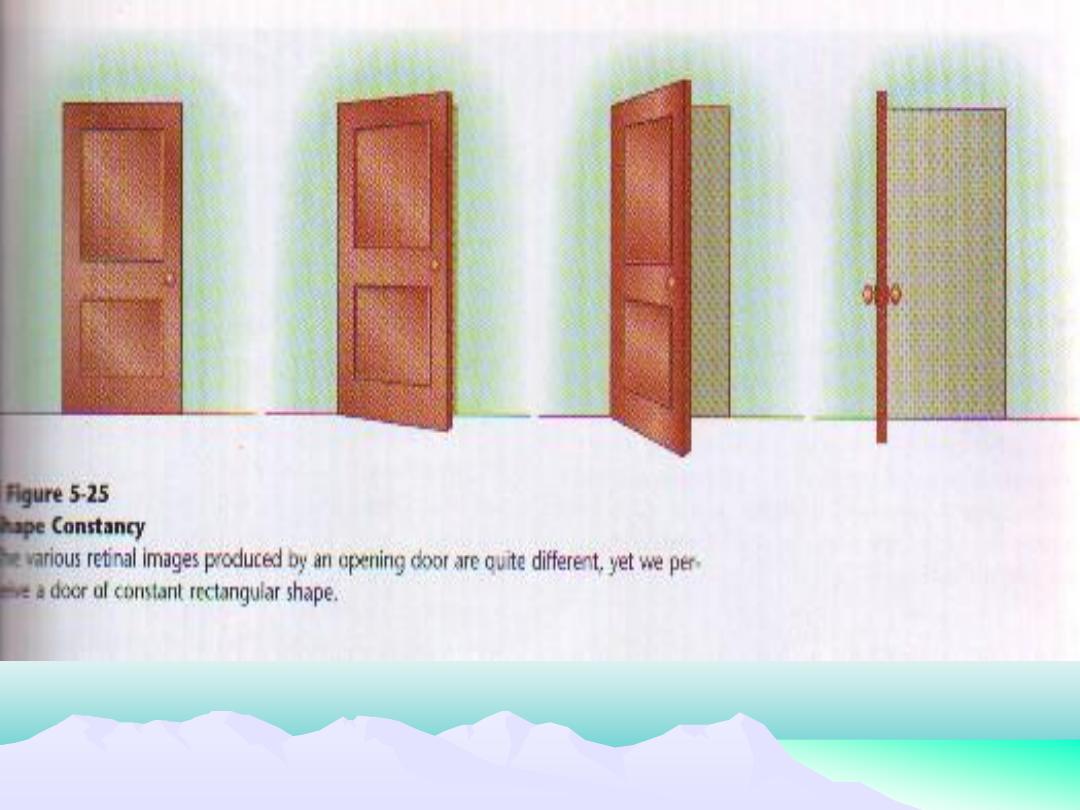
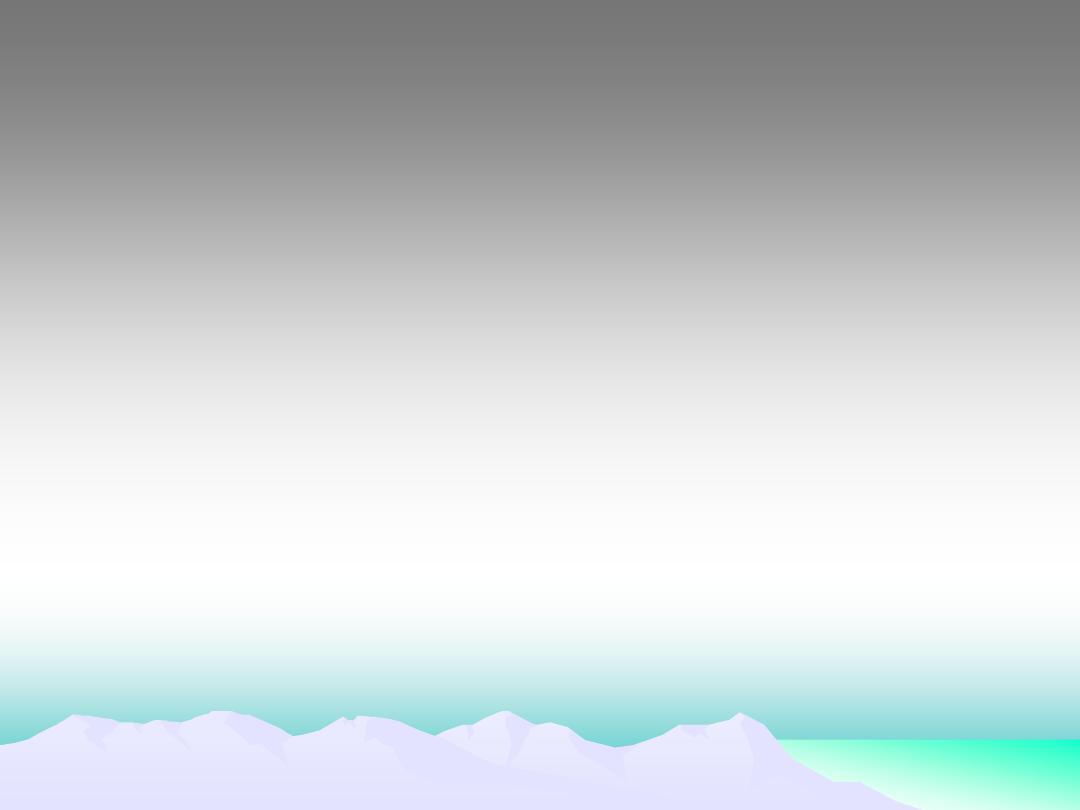
•
Size constancy
: the most thoroughly studied of
all the perceptual constancies. An object’s
perceived size remains relatively constant no
matter how far away it is.
•
As an object moves farther away from us ,we
generally do not see it as decreasing in size .
•
The perceived image of an object increases with
both the retinal size of the object and the
perceived distance of the object.
•
This explains size constancy as follows: when
the distance to an object increases ,the object’s
retinal size decreases, but if distance cues are
present ,perceived distance will increase. Hence
the perceived size will remain approximately
constant.
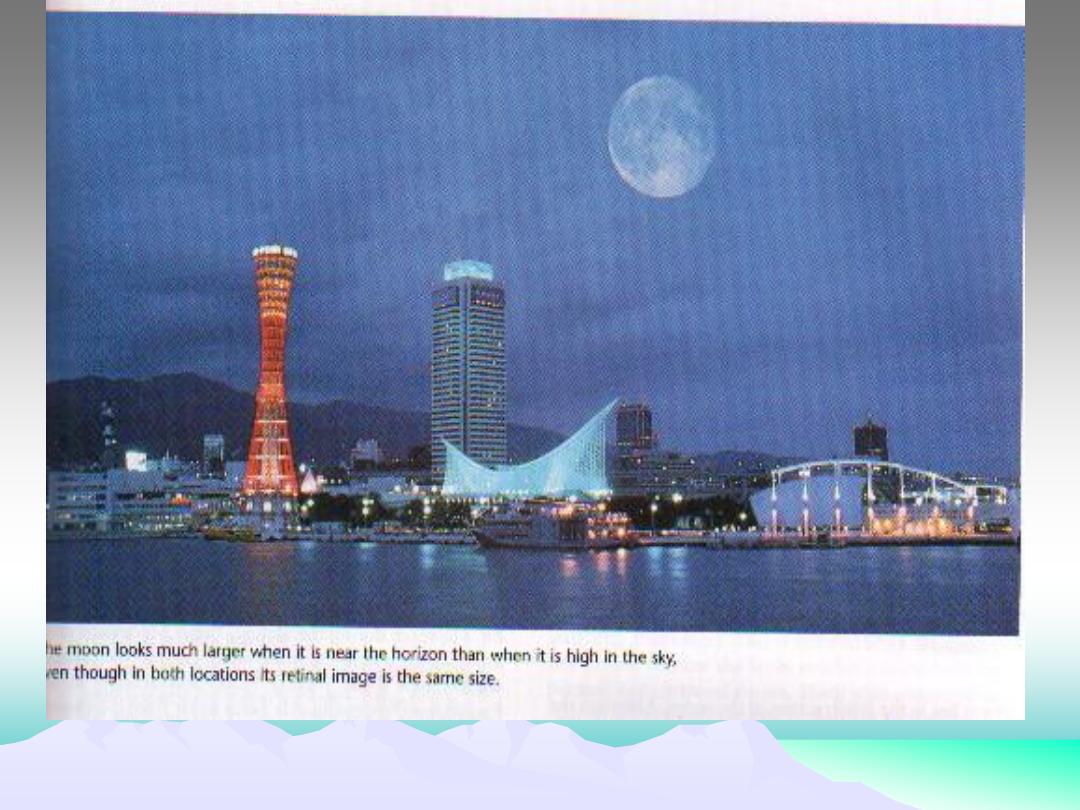
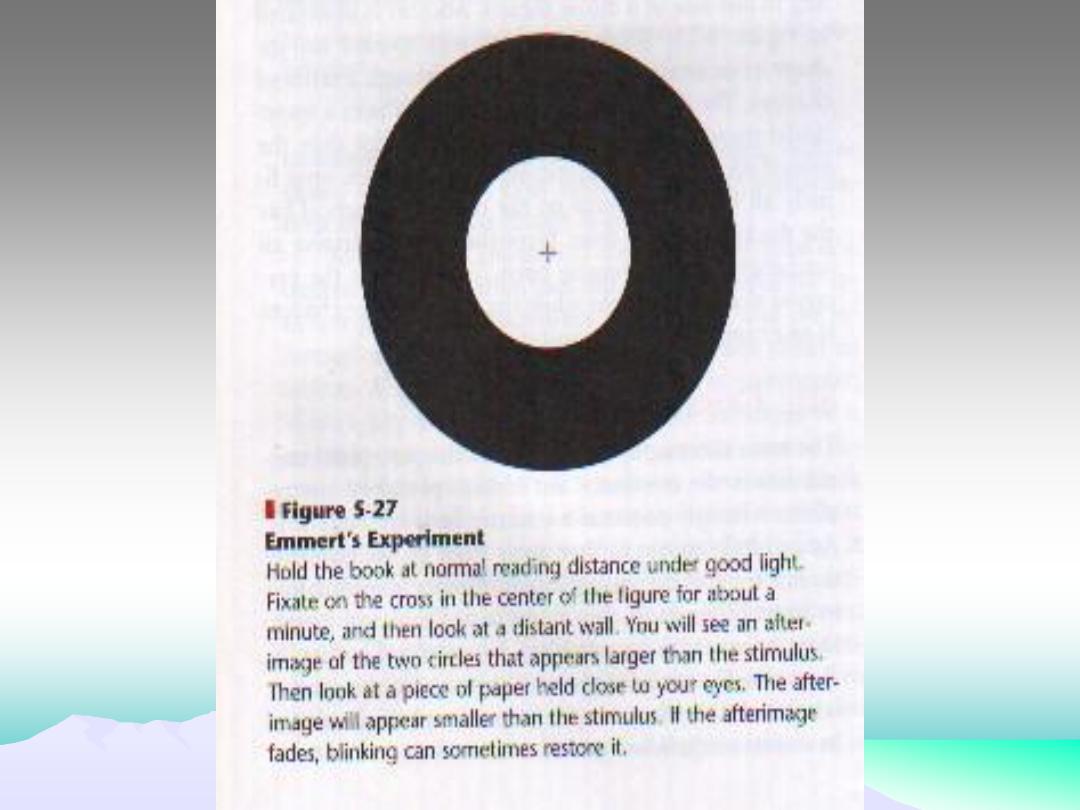
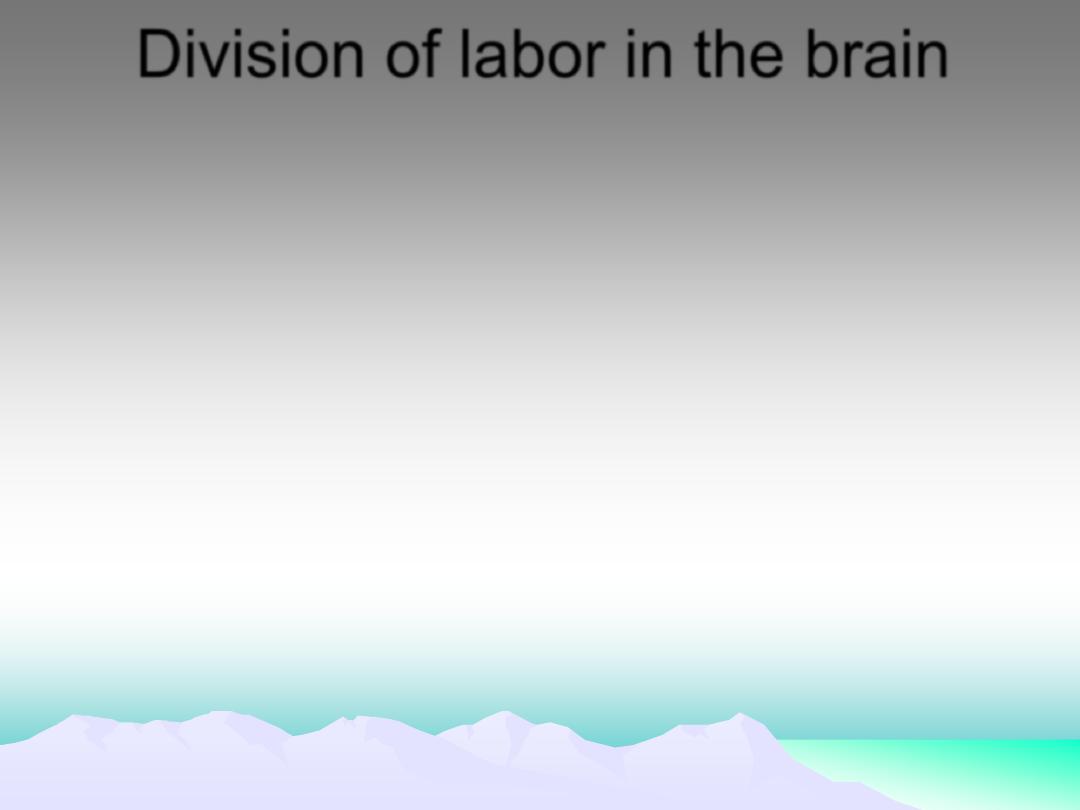
Division of labor in the brain
•
Two separate brain systems seems to mediate the
psychological act of selecting an object to attend to. The
posterior system selects objects on the basis of location
,shape ,or color, and the anterior system is responsible for
guiding this process, depending on the goals of the viewer.
•
The visual cortex operates according to the principle of
division of labor. Localization is mediated by a region near
the top of the cortex, and the recognition by a region near
the bottom of the cortex.
•
Recognition processes are further subdivided into separate
modules such as color shape and texture.
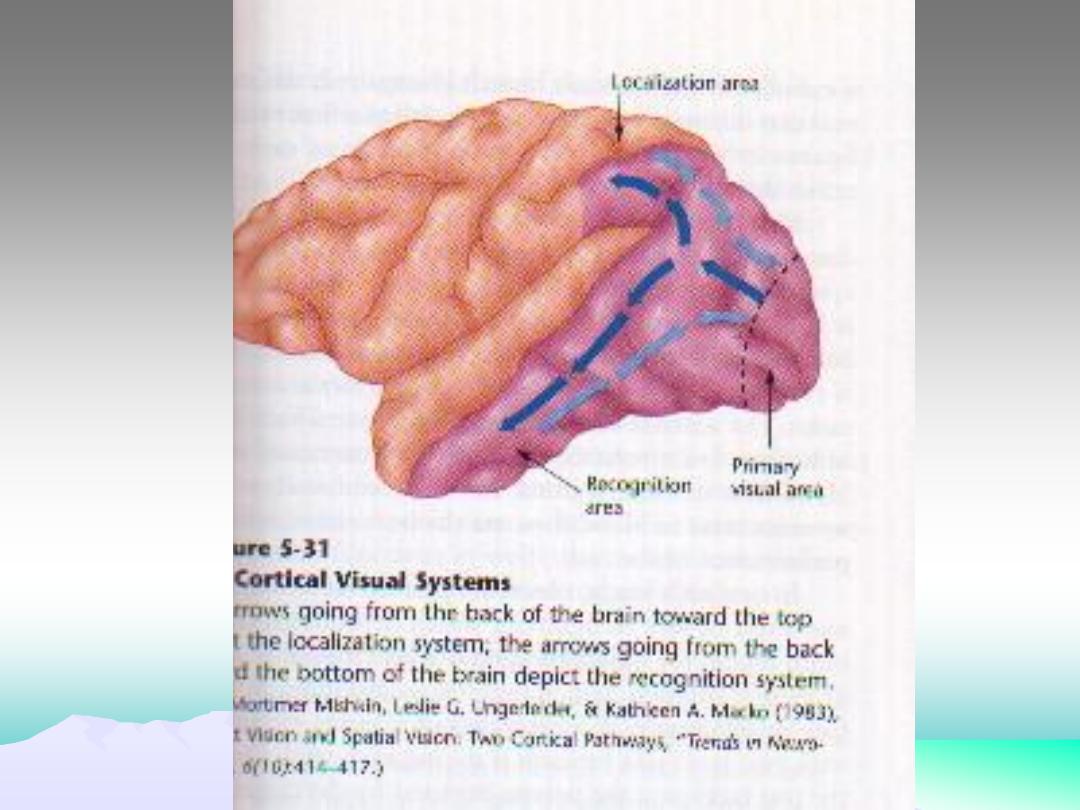
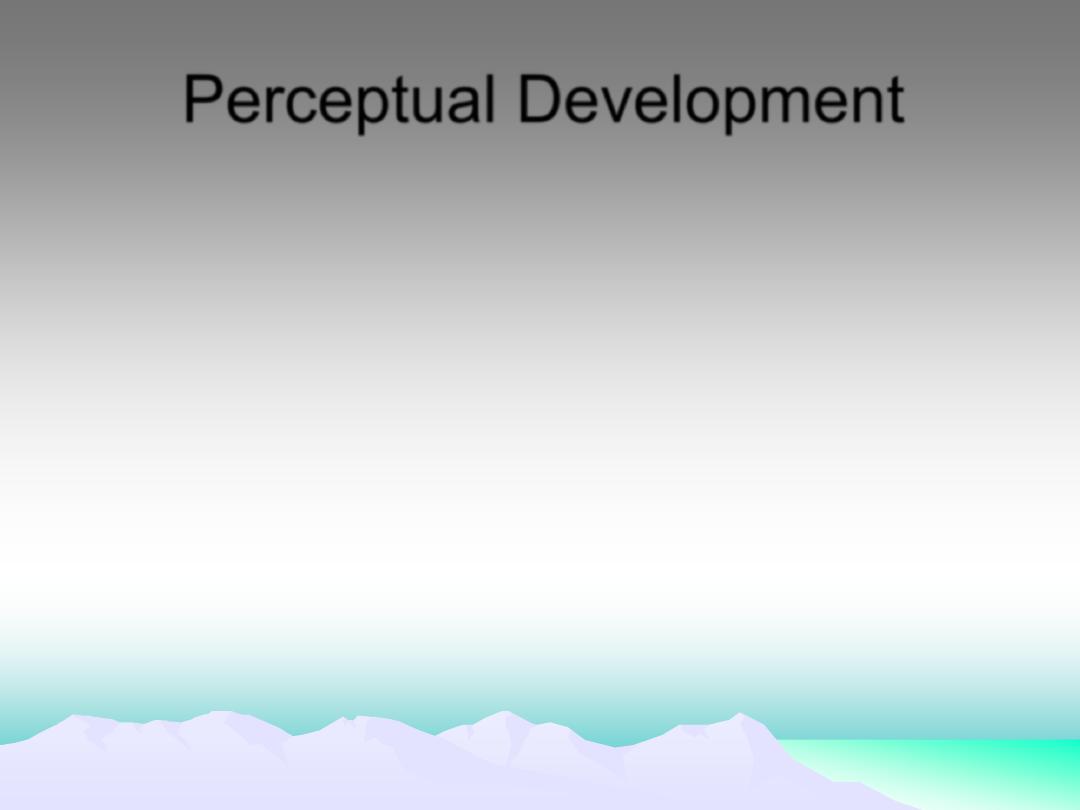
Perceptual Development
•
Research on perceptual development is concerned with
the extent to which perceptual capacities are inborn and
the extent to which they are learned through experience.
•
To determine inborn capacities ,researchers study the
discrimination capacities of infants with methods such as
preferential looking and habituation.
•
Perceptual constancies begin to develop as early as 6
months.
•
Animals raised in darkness suffer permanent visual
impairment ,and animals raised with a patch over one
eye become blind in that eye, suggesting a critical period
early in life when lack of normal stimulation produces
deficiency in an innate perceptual capacity.
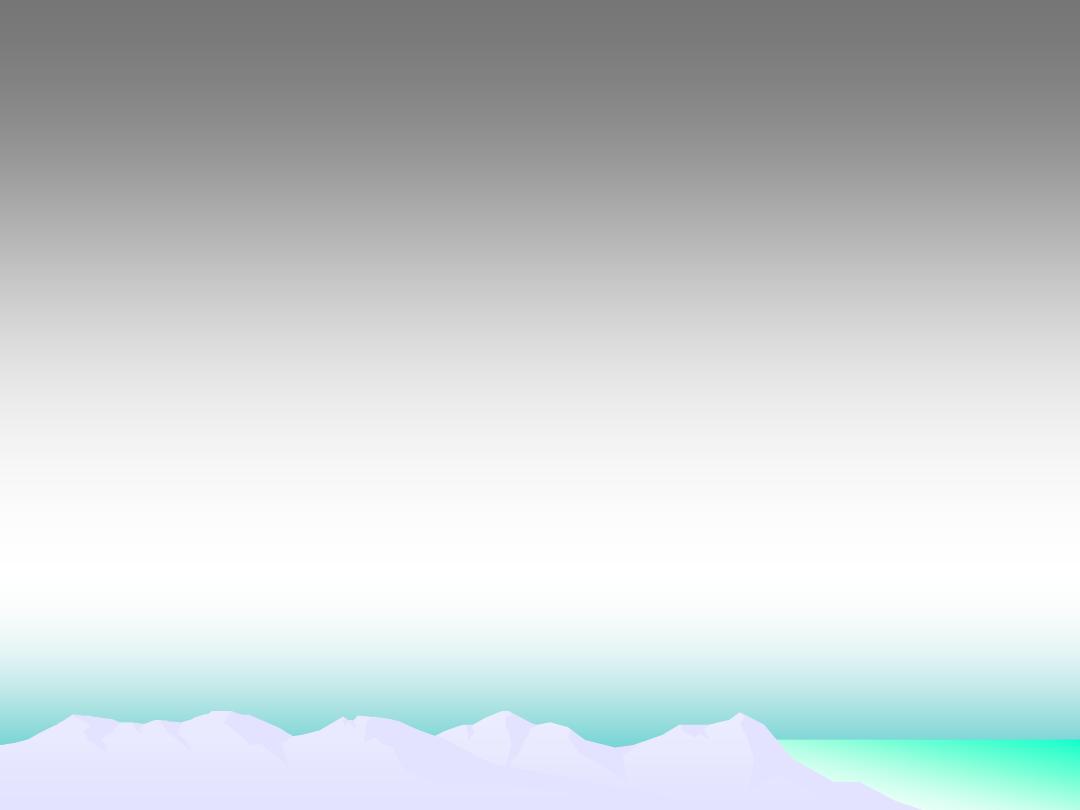
THANK YOU
